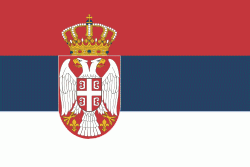Braničevo District (Branicevo)
The Braničevo District (Браничевски округ, ; Districtul Braničevo) is one of nine administrative districts of Southern and Eastern Serbia. It expands in the north-eastern parts of Serbia. According to the 2011 census results, it has a population of 180,480 inhabitants. The administrative center of the district is Požarevac.
It is named after the village of Braničevo.
In the 9th century, a Slavic (or Serb ) tribe known as Braničevci are mentioned living in the region. In this time, the town named Braničevo also existed in the area, at the estuary of the river Mlava into Danube. In the Early Middle Ages, Braničevo became a part of the First Bulgarian Empire. After the conquest of Bulgaria, the Byzantines established the Theme of Sirmium in the wider region south of the river Danube.
By the 12th century, Braničevo was the centre of a Byzantine doukaton (duchy) governed by a doux (duke). The region saw significant fighting between the Byzantines and Hungarians. With the rise of the Second Bulgarian Empire and the Kingdom of Serbia, Byzantium's position in Braničevo became untenable. It appears to have finally slipped from their control in 1198. It was a frequent object of contention between the Bulgars, Serbs and Hungarians thereafter.
In the 13th century the Hungarians established the Banate of Braničevo (Hungarian: Barancsi Bánság), but later in the century two local Bulgarian rulers, Darman and Kudelin, became independent and ruled over Braničevo and Kučevo. In 1291, they were defeated by the Serbian king, Stefan Dragutin, who joined Braničevo to his Syrmian Kingdom. Under his rule the town of Braničevo became a seat of the Eparchy of the Serbian Orthodox Church. The region later belonged to subsequent Serbian states, until it was conquered by the Ottoman Empire in the 15th century. In the 14th century, the region was in a possession of local rulers from the House of Rastislalić. During the Ottoman rule, Braničevo was part of the Sanjak of Smederevo, and since 19th century, it is again part of the Serbian state.
It is named after the village of Braničevo.
In the 9th century, a Slavic (or Serb ) tribe known as Braničevci are mentioned living in the region. In this time, the town named Braničevo also existed in the area, at the estuary of the river Mlava into Danube. In the Early Middle Ages, Braničevo became a part of the First Bulgarian Empire. After the conquest of Bulgaria, the Byzantines established the Theme of Sirmium in the wider region south of the river Danube.
By the 12th century, Braničevo was the centre of a Byzantine doukaton (duchy) governed by a doux (duke). The region saw significant fighting between the Byzantines and Hungarians. With the rise of the Second Bulgarian Empire and the Kingdom of Serbia, Byzantium's position in Braničevo became untenable. It appears to have finally slipped from their control in 1198. It was a frequent object of contention between the Bulgars, Serbs and Hungarians thereafter.
In the 13th century the Hungarians established the Banate of Braničevo (Hungarian: Barancsi Bánság), but later in the century two local Bulgarian rulers, Darman and Kudelin, became independent and ruled over Braničevo and Kučevo. In 1291, they were defeated by the Serbian king, Stefan Dragutin, who joined Braničevo to his Syrmian Kingdom. Under his rule the town of Braničevo became a seat of the Eparchy of the Serbian Orthodox Church. The region later belonged to subsequent Serbian states, until it was conquered by the Ottoman Empire in the 15th century. In the 14th century, the region was in a possession of local rulers from the House of Rastislalić. During the Ottoman rule, Braničevo was part of the Sanjak of Smederevo, and since 19th century, it is again part of the Serbian state.
Map - Braničevo District (Branicevo)
Map
Country - Serbia
 |
 |
| Flag of Serbia | |
Continuously inhabited since the Paleolithic Age, the territory of modern-day Serbia faced Slavic migrations in the 6th century, establishing several regional states in the early Middle Ages at times recognised as tributaries to the Byzantine, Frankish and Hungarian kingdoms. The Serbian Kingdom obtained recognition by the Holy See and Constantinople in 1217, reaching its territorial apex in 1346 as the Serbian Empire. By the mid-16th century, the Ottomans annexed the entirety of modern-day Serbia; their rule was at times interrupted by the Habsburg Empire, which began expanding towards Central Serbia from the end of the 17th century while maintaining a foothold in Vojvodina. In the early 19th century, the Serbian Revolution established the nation-state as the region's first constitutional monarchy, which subsequently expanded its territory. Following casualties in World War I, and the subsequent unification of the former Habsburg crownland of Vojvodina with Serbia, the country co-founded Yugoslavia with other South Slavic nations, which would exist in various political formations until the Yugoslav Wars of the 1990s. During the breakup of Yugoslavia, Serbia formed a union with Montenegro, which was peacefully dissolved in 2006, restoring Serbia's independence as a sovereign state for the first time since 1918. In 2008, representatives of the Assembly of Kosovo unilaterally declared independence, with mixed responses from the international community while Serbia continues to claim it as part of its own sovereign territory.
Currency / Language
| ISO | Currency | Symbol | Significant figures |
|---|---|---|---|
| RSD | Serbian dinar | дин or din. | 2 |
| ISO | Language |
|---|---|
| BS | Bosnian language |
| HU | Hungarian language |
| SR | Serbian language |


















